The labour market results from the Quarterly National Household Survey continue to be impressively positive. There is no doubt that this is a good thing, but the overall impact of the improvements remains uncertain. The employment gains are not be reflected in other data series: household disposable income, exchequer income tax returns, core retail sales etc.
In the standard discussion of recessions it is put forward that improvements in unemployment/employment lag behind a general upturn in the economy by two or more quarters. Ireland seems to be an unusual case where we are seeing employment improvements first.
The annual change in the number of people employed paints a very positive picture in recent quarters.
In percentage terms, employment is growing at close to rates, which unsurprisingly, have not been seen since 2006 and 2007. But overall conditions are not like they were then. Here are the annual percentage changes in total employment and aggregate wages received by households.
Employment growth has been positive in annual terms for more than a year. Growth in aggregate (nominal) wages remains absent, though the series only goes as far as Q3 2013 and recent data are subject to revision.
The pattern of household disposable income reflects the above changes in wages received. Here is the level of household disposable income for the past eight years. The point of note here is the absence of any notable upturn in 2013 (during which employment was growing).
Of course, even if aggregate wages were increasing the impact on disposable income would be offset by certain tax increases. However, if we are looking for labour market improvements it might be useful to just look at income tax. Cumulative income tax by month does not show any improvement in 2013 relative to 2012.
Finally, core retail sales could be used a positive affirmation of the labour market statistics. It is not much but a pattern of rising core retail sales since the spring of 2013 is discernible.
However, the increase is driven by volume (+2.7 per cent in the year to January) as opposed to value (+0.9 per cent on the year). We might be buying more but we are not really spending more (the motor trades excepted).
Of course, a drag on household spending continues to be the debt overhang that many households are carrying. The household sector continues to deleverage relatively rapidly.
Since peaking at nearly €204 billion at the end of 2008 the total loan liabilities had declined to €168 billion by the third quarter of 2013.
It would be useful to dig further into the QNHS figures but some re-classification problems mean that many of the sub-trend categories cannot be interpreted as actual changes. The CSO highlight this in relation to employment in the Agriculture, Food and Forestry sector (+26,800 but due more to statistical reclassifications than increased activity). This also has knock-on consequences for divisions into categories such as employee or self-employed, the patterns of which could be useful for explaining the wage, income and tax trends shown above.
So we are left with a position where labour market statistics are very positive – total employment up 3.3 per cent to the end of 2013 – but this is not reflected elsewhere. In nominal terms aggregate wages, income tax revenues, disposable income and consumption expenditure are all not doing much better than remaining static.
The increases in employment are undoubtedly positive but it is unusual that they are leading wage, income and consumption increases. It is not clear where these aggregates are currently heading but if the employment increases continue they will also start to rise. Surely?
Tweet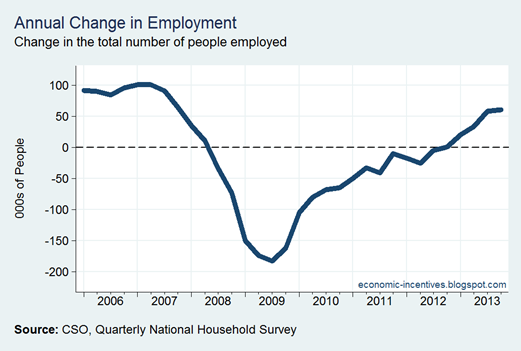
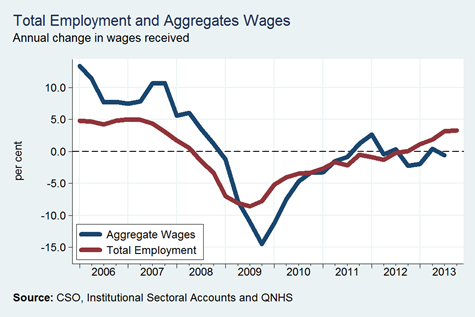
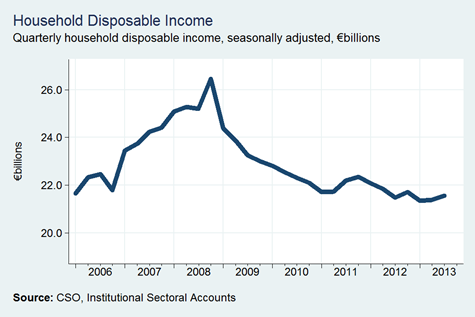

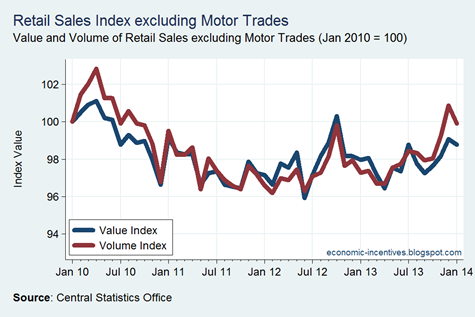
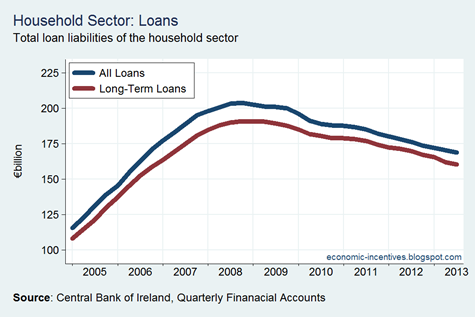



Seamus
ReplyDeleteLooking at the CSO QNHS, they do point out that they have adjusted their methods of calculating workforce post the publication of the census. Taking the increase in the numbers of self employed males involved in agriculture for example, I would suggest this is the reclassification of formerly part-time farmers as full-time ones, because they lost their off farm jobs, explains much of the increase. Alternatively, a couple of million acres of new land has been discovered after all the winter storms!
The lack of any real increase in Income Tax also suggests that even if there is an increase in employment, that it is of the low paid precarious sort, not the high paid, high tech ones that Governments have been promoting for many years. This would tie into the lack of any increase in retail sales, other than for cars. Even the car sales are being funded by the manufacturers' own banks in many cases.
The increases in Income tax yield in previous years was driven by tax changes introduced over years which have slowly taken effect. For example, the clawback on the use of certain reliefs by high earners, particularly since the threshold was dropped to €125,000. Increasing Income tax is not seen as an option by the Government in the future.
Perhaps this is as good as it gets?